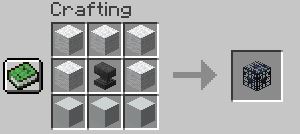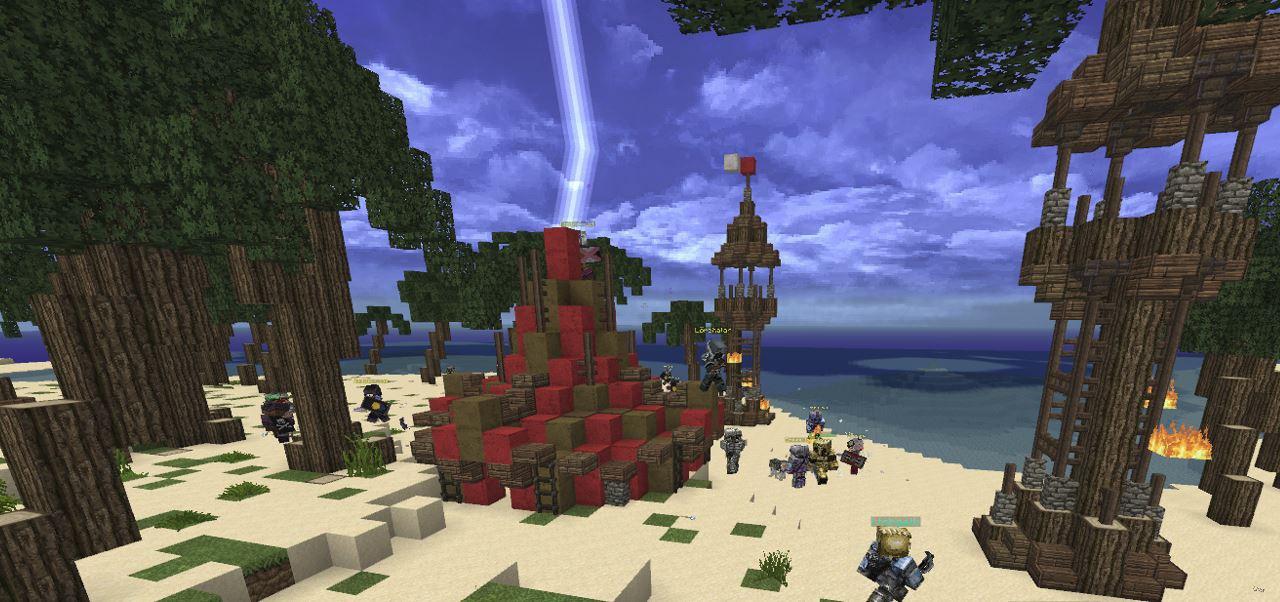
How to Engage in the War System:
1. Opting In: Setting Vulnerability Windows
Your nation can participate in wars by setting up *Vulnerability Windows*. These are specific time frames during the week when your nation is open to being attacked, indicating when you're available to engage in battles.
2. Finding an Enemy Nation
To engage in combat, locate another nation that has also opted into the war system. Use the `/siege` command to view when each nation is vulnerable for attack.
3. Preparing for Attack
Plan your attack to start 30 minutes before your target nation enters its Vulnerability Window.
4. Placing a Warcamp
Outside the town of the enemy nation, place a Camp and right-click the spawner to launch the attack. The Camp will transform into a Warcamp, marking the start of the battle.
5. Town Backup
The enemy town will be automatically backed up to a safe location before the battle begins.
6. Prelude Time (30 minutes)
Once the Warcamp is established, there will be a 30-minute *prelude* phase where both the attackers and defenders can prepare for the upcoming battle.
7. Teleportation for Allies
During the prelude, players allied with either the attackers or defenders will be given a one-time option to teleport directly to the battle zone.
8. Battle Commences
After the prelude ends, the town's block protection will be lifted, allowing full-scale combat. **Tip:** Using cannons is highly recommended to break through defenses.
9. Attackers' Objective
The attackers must reach the town's *Nexus*, destroy it, and loot the Silos. Any loot must be returned to their Warcamp.
*Note:* The Nexus has its own defense mechanisms, so proceed with caution.
10. Defenders' Objective
The defenders will win if they can survive long enough for the progress bar at the top of the screen to run out.
11. Postlude (15 minutes)
Once the battle concludes, a 15-minute *postlude* begins, allowing players to safely exit the battlefield via the portal in the Warcamp.
12. Exclusion Zone
After the postlude ends, an *exclusion zone* will be established around the town, making all its members invincible for a brief period.
13. Town Restoration
After a few minutes, the town will be fully restored using the previously created backup, returning everything to its original state before the battle.
Getting Started with Sieges:
Camps in Sieges
The core of warfare in Pactoria revolves around besieging enemy towns and outposts.
In a siege, plot protections are removed, giving you the ability to break and place blocks freely within enemy towns. You can also use fire, TNT, and other destructive tools without restriction. Don't worry about long-term damage—once the siege ends, the town will automatically be restored to its original state.
How to Start a Siege
To begin besieging a town, you need to set up a *warcamp* near the enemy's territory. These camps serve as critical respawn points, allowing your forces to regroup and continue fighting away from your home base.
By establishing a warcamp, you initiate the siege and can start advancing toward victory.

Vulnerability Windows
Vulnerability System Overview
To accommodate players with varying schedules, Pactoria requires towns to define 10 one-hour blocks per week during which they are available to defend their towns. Attacking nations can only launch an assault during these designated times, ensuring a fair and balanced system.
Setting Up Vulnerability Times
1. Set Your Time Zone
First, use the `/nation timezone` command to set your personal time zone. This will make sure that all times and dates for vulnerability windows are displayed correctly for you.
2. Define Vulnerability Hours
Use the `/siege vulnerability` command to open the Vulnerability Screen. This screen displays each hour of the week in colored squares, with each square representing one hour.
- Use the arrow banners to scroll up and down to view different hours.
- Select at least 10 hours when your nation is available to defend, and remember that these selections will repeat each week.
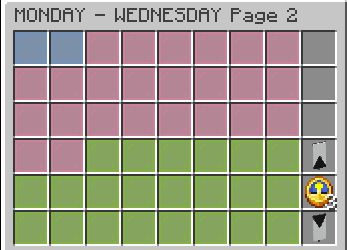
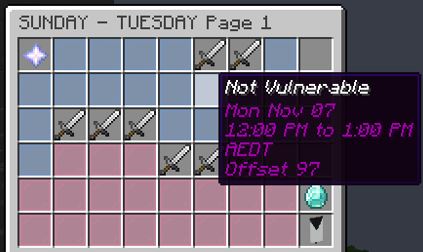
3. Confirmation of Setup
A diamond icon will appear once you have successfully set your vulnerability hours.
Key Strategy Tips for Attackers and Defenders
- For Attackers:
Keep in mind that the one-hour prelude must end within the defender’s Vulnerability Window. Since the prelude itself lasts an hour, you must launch the attack before the Vulnerability Window opens.
- For Defenders:
Be aware that battles may extend beyond your designated Vulnerability Window. Although your window defines when you can be attacked, the actual fight may last longer. Plan accordingly to sustain defenses throughout the entire battle.
Warcamps in Sieges
What is a Warcamp?
A Warcamp is a special type of camp used to start a siege to suppress a town’s block protections, allowing attackers to break and place blocks. A camp becomes a warcamp when it is activated by right-clicking the spawner and selecting the town to attack.
Acquire warcamps from your silo's or craft them using the recipe:
5x Wool, 3x White concrete, 1x Anvil.
Warcamp Mechanics 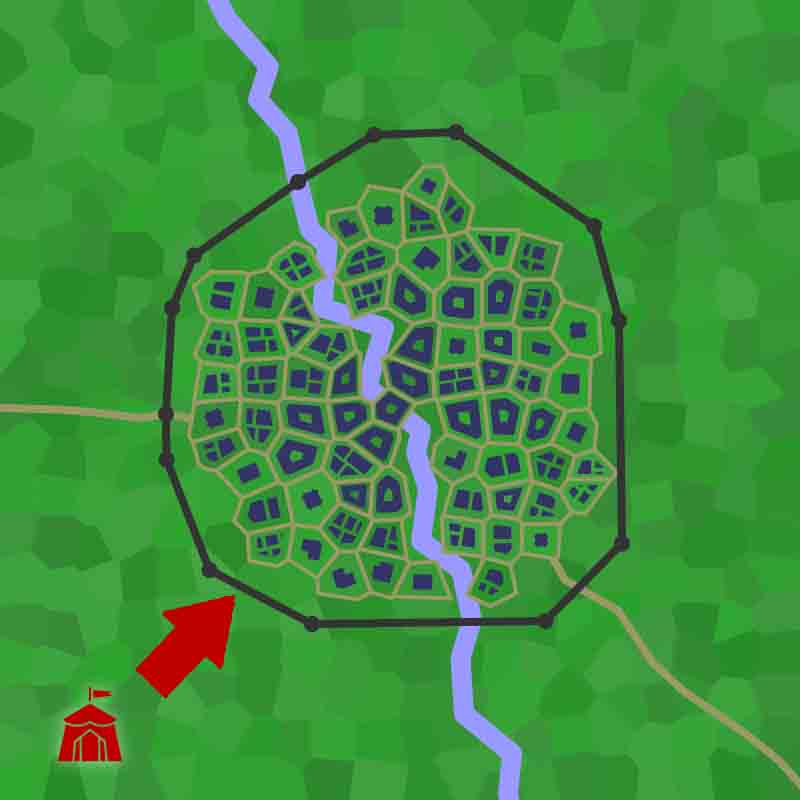
Make sure your war camp is at a safe enough distance as this is where you will respawn.
- Guard Spawns:
Warcamps will still spawn guards, but defeating them won’t directly affect the health of the Warcamp.
- Warcamp Health:
The Warcamp’s health gradually decreases over time and each time a player spawns at it. The siege ends if all the attackers' Warcamps reach zero health or if the Nexus is brought back to the Warcamp.
- End of Siege:
When a Warcamp reaches zero health or the Nexus is captured, a portal will appear where the Warcamp stood, allowing players to return to their towns.
- Manual End:
The Warcamp owner can also manually end the attack at any time by breaking the spawner.
Health Bar
The bar at the top of the screen represents the combined health of all the attackers’ Warcamps.
Alliances and Joining a Siege
Any nation can join an ongoing siege, provided they have a two-way alliance with either the attackers or defenders. Players can simply arrive at the battle to join.
Siege Phases
Sieges are divided into three distinct phases:
1. Prelude Phase – Preparation Time
- Duration: 30 minutes (or 5 minutes for unclaimed NPC outposts).
- Purpose: Both sides use this time to prepare for the upcoming battle.
- Block Protection: During the Prelude, block protections remain in place, preventing any destruction.
2. Main Phase – The Battle Begins
Start: Once the Prelude ends, the real battle begins.
Action: Block protections are lifted, allowing attackers to use fire, TNT, and other destructive methods.
Key Mechanics:
- Soft Blocks: Attackers can break soft blocks (e.g., dirt, obsidian, sand, glass) with tools.
- Hard Blocks: Hard blocks (e.g., stone) can only be broken using explosives.
- Objective: The goal is for attackers to destroy the enemy Nexus (attack it with a sword repeatedly) and carry it back to their Warcamp. The Nexus will actively fight back.
- Defenders' Role: Defenders must prevent the attackers from capturing the Nexus.
- Boos Bar: When attackers die, the bar at the top of the screen decreases. It also ticks down over time, so attackers need to act quickly. If the bar reaches zero, the defenders win.
3. Postlude Phase – Withdrawal
- Purpose: After the battle, this phase provides time for players to withdraw from the town.
- Portal: A portal will appear in the Warcamp, allowing players to return home safely.
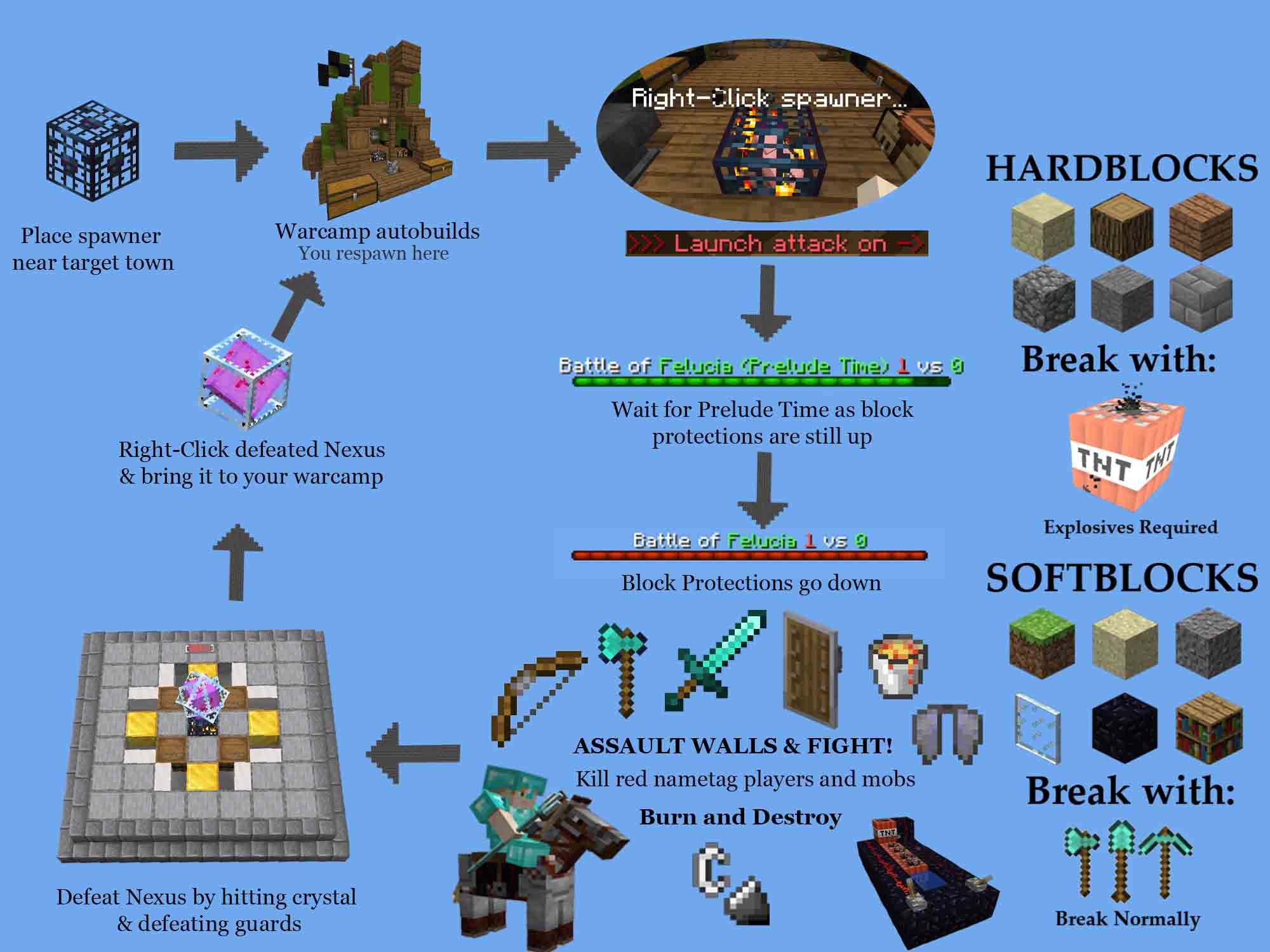
Blocks, Chests, and Items in Sieges
Block Protections
Once the prelude ends, a town's block protections are reduced but not completely removed. Attackers can interact with the town’s environment under the following rules:
Breaking Soft Blocks
Attackers can break soft blocks using tools, although at a slower pace than usual.
- Examples: sand, glass, dirt, flowers, and even obsidian (as it can’t be destroyed by explosives).
- Any block placed by attackers during the siege is also considered a soft block.
Breaking Hard Blocks
Hard blocks, such as wood and stone, cannot be broken with tools and must be destroyed using explosives like TNT or cannons.
- Examples: wood, stone, and other strong building materials.
Explosives and Restrictions
Attackers can use explosives to break through hard blocks but must follow these rules:
- No redstone-related blocks can be placed within the town.
- Blocks cannot be placed above the town’s highest point.
Chests, Doors, and Items:
Chest and Door Protection
Chests and doors are immune to explosives during the siege. If an attacker breaks a chest, no items will drop, and the chest will respawn in its original location after a few minutes.
Accessing Silos
While attackers cannot open regular chests, they can access the town’s Silos. Silos always contain items for attackers, even if defenders have emptied them beforehand. This makes capturing Silos a critical objective for attackers.
The Siege Zone
What is the Siege Zone?
When an attack is initiated by a Warcamp, an imaginary rectangle is drawn around both the town and the attacking Warcamps. This designated area is known as the Siege Zone.
You can tell you’re inside the Siege Zone by the bar that appears at the top of your screen.
Key Rules for the Siege Zone
Constant Presence of Attackers: At least one attacker must remain within the Siege Zone at all times. If all attackers leave the zone, they automatically lose the battle.
Expanding the Siege Zone: If additional Warcamps join the attack, the Siege Zone will expand to include those new camps, enlarging the battle area.
The Siege Zone serves as the battleground for both attackers and defenders, and controlling it is essential for victory.
Death and Spawning in Sieges
The spawning system in Pactoria is designed to get you back into the action as quickly as possible after death. Here’s how it works during a siege:
Death in a Siege Zone
- When you die in a siege zone, you keep most of your items. However, there’s a small chance that some items may drop upon death.
Attacker Respawns
- Warcamps: If you’re an attacker, you will respawn at your Warcamp. Warcamps are protected from block destruction and spawn guards to help defend them.
- Allied Warcamps: If your nation doesn’t have a Warcamp in place, you will be sent to an allied Warcamp instead.
Defender Respawns
- Choosing a Spawn Point: Defenders have more flexibility in choosing where they respawn.
- You can set your personal spawn point anywhere in the town using the
/town spawncommand. - Alternatively, you can set a default spawn for the entire town with the
/town default-spawncommand.
- You can set your personal spawn point anywhere in the town using the
- Allied Respawns: During a siege, allies will also spawn at your town’s default spawn unless there is a Warcamp set up for them. Consider placing a camp inside your own town to give allies a safer spawn point and a way to leave when the siege ends via the Exit Portal.
Starter Exploration Camps
- Restrictions: The starter exploration camp cannot be used in sieges. It won’t function within a siege zone, and it won’t respawn you if you die during the siege.


